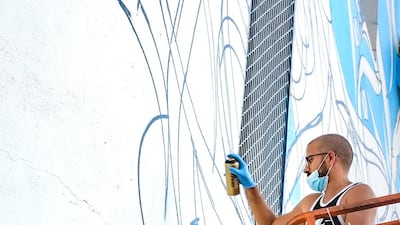Earlier this year, renowned French-Tunisian graffiti artist eL Seed brought his work to Ajman, scrawling Sheikh Zayed's words in black, painting spaces between loops azure, sapphire and sky-blue and turning an ordinary building into a canvas.
This was not eL Seed’s first artwork in the Emirates. He undertook a residency in Dubai’s Tashkeel, has a studio in Al Quoz art district and painted the words of Iraqi poet and Sharjah resident Ahmed Bu Sneeda across an abandoned building on Bank Street. Yet he is perhaps best known for his work in overlooked neighbourhoods in Rio di Janeiro, Cape Town and on the Coptic community of marginalised rubbish collectors in Manshiyat Nasr, Cairo.
Ajman, as a beautiful but invisible emirate, is therefore fitting. The calligraffiti in Sharjah’s heritage district attracts regular admirers. Few venture to eL Seed’s mural in Ajman, painted in a neighbourhood that appeals less to tourists and more to those who call the Gulf home. Its make-up is from a time that isn’t quite past us but near enough to be on the cusp of nostalgia.
Even its ambiguous address is a throwback. Google Maps places it at the intersection of Al Ittihad Street and Badr Street. Residents know the area as Old Immigration Road and Bustan Street, and it is signposted Sheikh Rashid Bin Abdul Aziz Street and Sheikh Abdullah Bin Humaid Street. Ajmanis call the area “downtown”. And yes, the building is between a mosque and a petrol station. It’s familiarity makes it hard to find. The setting? Equally familiar.
Kitty corner: Al Burj Saloon, Al Zahran Flour Mills, Madeenat Al Shai Cafeteria and a cobbler who sits with his gear on the sidewalk. Next door, Al Boom Video sells '90s pop and compilation CDs by Ajmani Tarab singers.
Backside: an empty lot where employees of Sharjah's Swiss-Belhotel practice every day before sunset for a match against a rival hotel. They have played cricket here for as long as anyone can remember, which is 13 years. A group of Pakistani men play at the other end of the lot. They have never played each other. On the front steps: Al Mawakeb Foodstuff Trading, the type of baqala that's got banana bunches dangling from strings.
Inside the eL Seed building, neighbours know each other by name and flat number. At six floors, this building – a high-rise in its day – escapes the anonymity that comes with height and glass facades. The landlord is compassionate if tenants fall on hard times.
____________________
Read more:
eL Seed gives Paris his artistic love with new exhibition
eL Seed's towering new text in Ajman
Hurufiyya: when modern art meets Islamic heritage
____________________
eL Seed met residents as he worked. "He showed us everything," says Ahmed Mohammed, a 24-year-old graduate. He lives on the landing with his mother, father, two brothers and two sisters. They lived on the second floor in 2003 but moved down after his sisters were born. Ahmed's parents, from Ajman and Saudi Arabia, moved from Musharif near Ajman City Centre Mall, at that time when it was a misnomer, out in the boonies and not among the criss-crossing flyovers and traffic of today. So his parents moved to the city centre, here on Bustan and Al Ittihad streets. Or Bustan and Immigration.
On the second floor is the owner of the building’s ground floor: China Town Restaurant, Lekhnath Bashyal of Nepal. Bashyal, 40, has worked at the restaurant since it opened in 2001, after a chance meeting over dinner with some Chinese restaurateurs at a Bur Dubai “disco kitchen”.
Bashyal was on holiday. He was not looking for a job in the UAE but by the end of his meal, he was employed. "At that time, [I had] no experience," he says. Today he is the owner. "I am everything. All-rounder."
On the fifth or third floor lives Mohammed Ayoub, imam of the mosque below, and his wife, daughter and three sons. Ayoub, 48, from Burma, first lived in the Al Karama neighbourhood before being assigned the flat above the Sheikha Bint Ahmed mosque, which holds about 140 worshippers and was built before the mega-mosque craze hit, when mosques were small and plentiful. It overflows with worshippers at sunset prayers, "and in Ramadan, mashallah, everyone who prays here, eats here", says Ayoub, who moved to the Emirates in 1994. He and his family were initially perplexed by eL Seed's painting until he learned its meaning. "He said these are the words of Sheikh Zayed, mashallah."
It says: “On land and in the sea, our forefathers lived and survived in this environment. They were able to do so because they recognised the need to conserve it, to take from it only what they needed to live, and to preserve it for succeeding generations.”
This is just one of the painted buildings in Ajman. The municipality has invited artists to paint murals around the emirate, an invitation for people to stop by. It is those who pass through – residents of other emirates – who will find the greatest satisfaction from a visit to the eL Seed building of Al Ittihad Street – not only for the art, but to find a place that still represents what the Emirates was.

